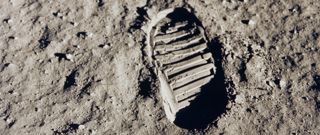
Astrolympics
- 11th Aug 2024
- Author: Sophie Allan
Like many of you, we have been gripped by Olympics fever, celebrating the successes of our athletes and marvelling at what they, with the right combination of talent, training and hard work, are able to achieve. And like many of you who have asked, we would also like to know how the Olympics might work elsewhere in our Solar System. So, we decided to have a go at working it out and are proud to present the results of the first (theoretical) Astrolympics on Mars and the Moon!

Gravity
We have selected four Olympic track and field events to break down, using the current (at time of writing) Olympic records as our markers. Our four events are:
- High Jump
- Shot Put
- Long jump
- Running
To keep this as simple as possible (spoilers, even the simple version gets a little complicated in places) we are making one key assumption. Our events on the Moon and Mars are taking place in a dome with an atmosphere that has the same pressure and density as the air at the surface of the Earth. This means our Astrolympians don’t need to wear a bulky space suit and can conduct themselves as they normally would for these events.
It also means that the only real factor we need to consider in our modelling is gravity.
The Earth, Moon and Mars all have different surface gravities which we give the symbol g. This is the gravitational field strength and tells us two equivalent things:
- The force per kg that gravity is pulling on each kg of mass of an object at the surface.
- The acceleration (rate of speed increase) that an object will experience as it falls due to gravity at the surface.
On Earth, g = 9.81ms-2 meaning if you drop an object, it will get faster at a rate of 9.81 metres per second every second, as long as it is in freefall (and you ignore that pesky air resistance – more on that later!).
On Mars, g = 3.71 ms-2, about 2.7 times smaller than on the Earth. On the Moon g = 1.62ms-2 or six times smaller.
So, with that in mind, let the first event begin – the high jump!
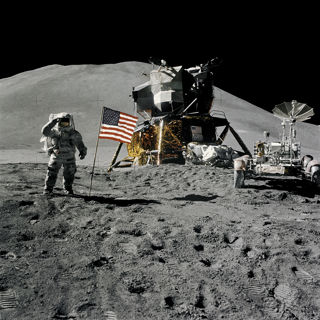
High Jump
Earth Olympic record:
- Women's: 2.06m - Yelena Slesarenko (Russia) - Athens 2004
- Men's: 2.39m - Charles Austin (USA) - Atlanta 1996
If we keep it simple, ignoring the run up and assuming the high jumper is only jumping up vertically, then gravity is the only factor to consider.
For a given vertical launch velocity, you can calculate the height a projectile (or a human in this case) will reach using the equation.
Height = (velocity2)/2g
g is the gravitational field strength. Since everything else is the same as on Earth, this means that the height reached and gravitational field strength are inversely proportional – if g gets smaller H gets bigger. So, a high jumper on Mars could expect to reach 2.65 times the height they could on Earth and 6 times the height on the Moon!
And our first results are in!
|
|
Women’s record (m) |
Men’s record (m) |
|
Earth |
2.06 |
2.39 |
|
Mars |
5.45 |
6.32 |
|
Moon |
12.49 |
14.49 |
But what about when something is being thrown up AND along, like in the shotput?
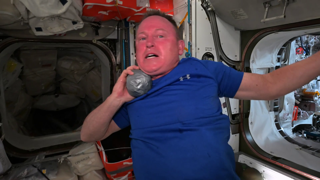
Shot Put
Earth Olympic Record:
- Women's: 22.41m - Ilona Slupianek (East Germany) - Moscow 1980
- Men's: 23.30m - Ryan Crouser (USA) - Tokyo 2020
To keep this simple we are assuming that the shotput is thrown from a stationary standing position because, as you will see, the gravity will also affect things like running speed. This means that we only need to consider gravity as a differing factor.
When the shot is thrown, its velocity is made up of a horizontal and vertical component. As soon as it leaves the athlete’s hand, it experiences no acceleration in the horizontal direction (so ignoring air resistance travels at a constant speed horizontally) and an acceleration downwards of g, which initially slows it down as it reaches the peak of its path, then accelerates it back down towards the ground. We call the path it follows a parabola, and this kind of motion where gravity is the only acceleration present is called projectile motion.
We can work out how far an object will travel for a given total velocity using the range equation:
Range = v2 sin(2θ)/g
Again, assuming velocity (v) and the launch angle (θ) remain the same as with the Earth Olympic record throw, the only thing changing is the surface gravity (g). Once again, we have an inversely proportional relationship yielding the following results:
|
|
Women’s record (m) |
Men’s record (m) |
|
Earth |
22.41 |
23.30 |
|
Mars |
59.29 |
61.64 |
|
Moon |
135.82 |
141.21 |
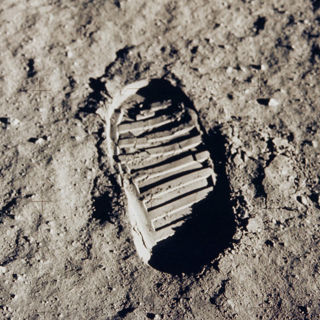
Long Jump
Earth Olympic record:
- Women's: 7.40m - Jackie Joiner-Kersee (USA) - Seol 1988
- Men's 8.90m - Bob Beamon (USA) - Mexico 1968
Initially we can model long jump in the same way, as a human launching themselves with a set speed and launch angle. So, assuming that these were the same as on Earth, we get further distances for both Mars and the Moon.
|
|
Women’s record (m) |
Men’s record (m) |
|
Earth |
7.40 |
8.90 |
|
Mars |
19.57 |
23.55 |
|
Moon |
44.84 |
53.94 |
However, we haven’t taken into account the running component of the long jump. The higher the run up speed, the longer the jump! How would running be different on the Moon or Mars?
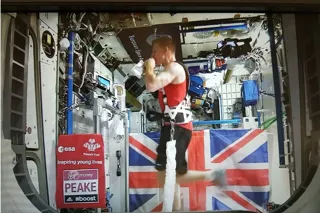
Running
To work out how running speed would be affected on the Moon and Mars we need to break down the physics of running.
To move forwards, a sprinter’s foot needs to be in contact with the ground. While it is, they can push against the track and the friction from the track will push back on the sprinter, propelling them forwards.
In addition, the contact force with the ground pushes them up, and they temporarily lose contact with the ground, moving through the air like a projectile with constant horizontal motion while they bring their back foot to the front to push off again.
The time the runner is in the air for is a set constant time – the time it takes for their legs to mechanically switch position. The contact time with the floor decreases as they get faster – leading to an increasingly slower overall acceleration (rate of getting faster) (from this paper in the Journal of Applied Physiology).
With less gravity, the sprinter will actually be in the air for a longer amount of time during each flight phase assuming they pushed off at the same angle as they do on Earth. This would not only mess up their timings for switching legs but would increase the time between being in contact with the ground (reducing their overall forwards acceleration). This means that for a sprint, their times would actually be higher!
But what if they changed the way they ran? Since the time in the air increases as the surface gravity drops, on Mars they could change their pushing angle so that more force is exerted in the direction of travel – resulting in a higher acceleration. With an adjusted running style, it would be possible to have a much higher top speed, and so middle and long distance records would certainly be smashed!
There is one more factor to think about – the friction itself. Frictional force depends on two things – how smooth the surface is (we call this the coefficient of friction which has the symbol µ) and the weight of the object. For the floor to push back on us (and propel us along) the force exerted in the horizontal direction needs to be less than the weight of the runner times the coefficient of friction. On a body with lower gravity, this means that the friction we can use is actually LOWER!
So, when it comes to running, it’s pretty clear we will need to experiment with the best technique, and it’s really difficult to come up with a definite outcome – we’ll just have to get out there and try it!

